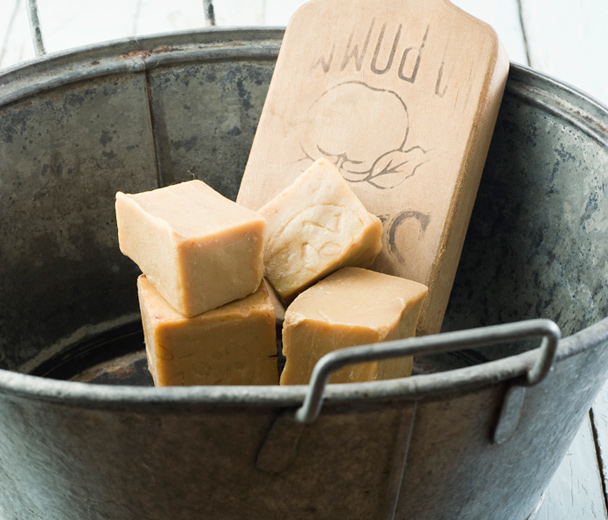My career as a baker has to a great extent been defined by yeast. Of course, the species of yeast that is dearest to me is the one that leavens bread dough, Saccharomyces cerevisiae. This affinity for fermenting grain is, for bakers, what makes it special among the 600 or so other yeast strains that ferment grapes, grain, molasses, and potatoes for wine, beer, and whiskey, or that cause all sorts of bodily afflictions like prickly heat, athlete’s foot, and candidiasis. Since my relationship with yeast, while deep and abiding, exists in the narrow, though wide-reaching context of bread, that’s what I’ll be focusing on in this primer.
Yeast is, both literally and metaphorically, a transformational agent, in that it has the ability to change things into something else, through the process of fermentation. In bread baking we refer to it as leaven, which means “to raise, to bring to life or vivify”; yeast turns a lifeless lump made from flour, salt, and water into a living, growing mass that we then call bread dough. For this reason, yeast has an almost magical or alchemical reputation. Before the late 19th century, when scientists were able to begin analyzing it properly, yeast was viewed with an even greater sense of almost mystical awe, but now, even though we know what it is and how it functions, it still retains an aura of mystery.
What Is Yeast?
Yeast, in its categorical sense, is a fungus, from the same general kingdom as other fungi such as mushrooms, truffles, and molds. There are more than 100,000 formal species of fungus but some scientists believe there are probably more like 1.5 to 5 million uncataloged types. Because the cell walls are made of a substance called chitin rather than cellulose (as found in plants), and do not produce chlorophyll, fungi are not considered part of the plant or animal world, but exist in their own distinct kingdom. Fungi can be visible to the naked eye, such as with mushrooms, or can be microscopic in size, as are the single-celled fungi that fall in the genus we know as yeast.
As with bacteria, yeast and other fungi can be beneficial—serving as the basis of many foods as well as medicines such as penicillin and other antibiotics—or harmful, toxic, or psychotropic. (Indeed, fungi can be transformational by either healing or killing us.) And, while yeast fungi have been acting upon other organisms in the world for millions of years, living in both combative and symbiotic relationships with bacteria, plants, and animals, it has been only about 6,000 years (as far as history can tell us) that they have come under directed application and cultivation to do our bidding.
How Is Commercial Yeast Manufactured?
Commercial yeast production, a late-19th-century innovation, is a fascinating process. I often show my baking students a video, made a number of years ago by the Fleischmann Yeast Company, of how baking yeast is manufactured. A small vial of active yeast cells is inoculated into a large vat of carbohydrate-rich water, spiked with molasses and other nutrients. It is then pumped with air, causing the yeast to rapidly reproduce through a process called budding, splitting into 2 identical cells, then 4, then 8, then 16, and on and on until, in just hours, the entire vat is swimming with trillions of living Saccharomyces cerevisiae cells. This yeasty liquid is then either shipped as fluid “cream yeast” to large-scale production bakeries, or dried on rotating drums into a paste-like substance that can be pressed into cakes and sold to smaller bakeries and even to home bakers through a few specialty markets as fresh, compressed yeast (aka “baker’s yeast”). Or, the liquid can be dried even further into a dry granulated powder called dry active yeast, to be used by both home and commercial bakers. More recently (for about 40 years or so now), a heartier, newer strain of Saccharomyces cerevisiae has also been cultivated and then dried into an even smaller sandlike grain and packaged under a variety of product names such as instant yeast, bread machine yeast, perfect rise yeast, or rapid rise yeast.
How Yeast Works: Feeding and Fermentation
What was so fascinating about the video was that it showed how quickly the yeast cells multiplied under those ideal growth conditions in the lab, but how much more slowly and differently they worked when deployed in bread dough. This is because yeast can grow both aerobically and anaerobically, but it multiplies much faster when in the presence of lots of dissolved oxygen in that vat pumped with bubbles of air. In bread dough, though, which has little air, it must rely on slow, anaerobic growth, fed by available sugar in the dough rather than by oxygen. Hardly any multiplication or budding of the yeast occurs in dough; instead, the yeast metabolizes the sugars and breaks them down—it ferments them, causing them to release carbon dioxide (like burping) and ethyl alcohol, or ethanol (like sweating). The rate of this fermentation is directly proportional to the temperature of the dough; the warmer it gets the faster the metabolic transformations take place—to a point (more on that later).



 Pinterest
Pinterest


